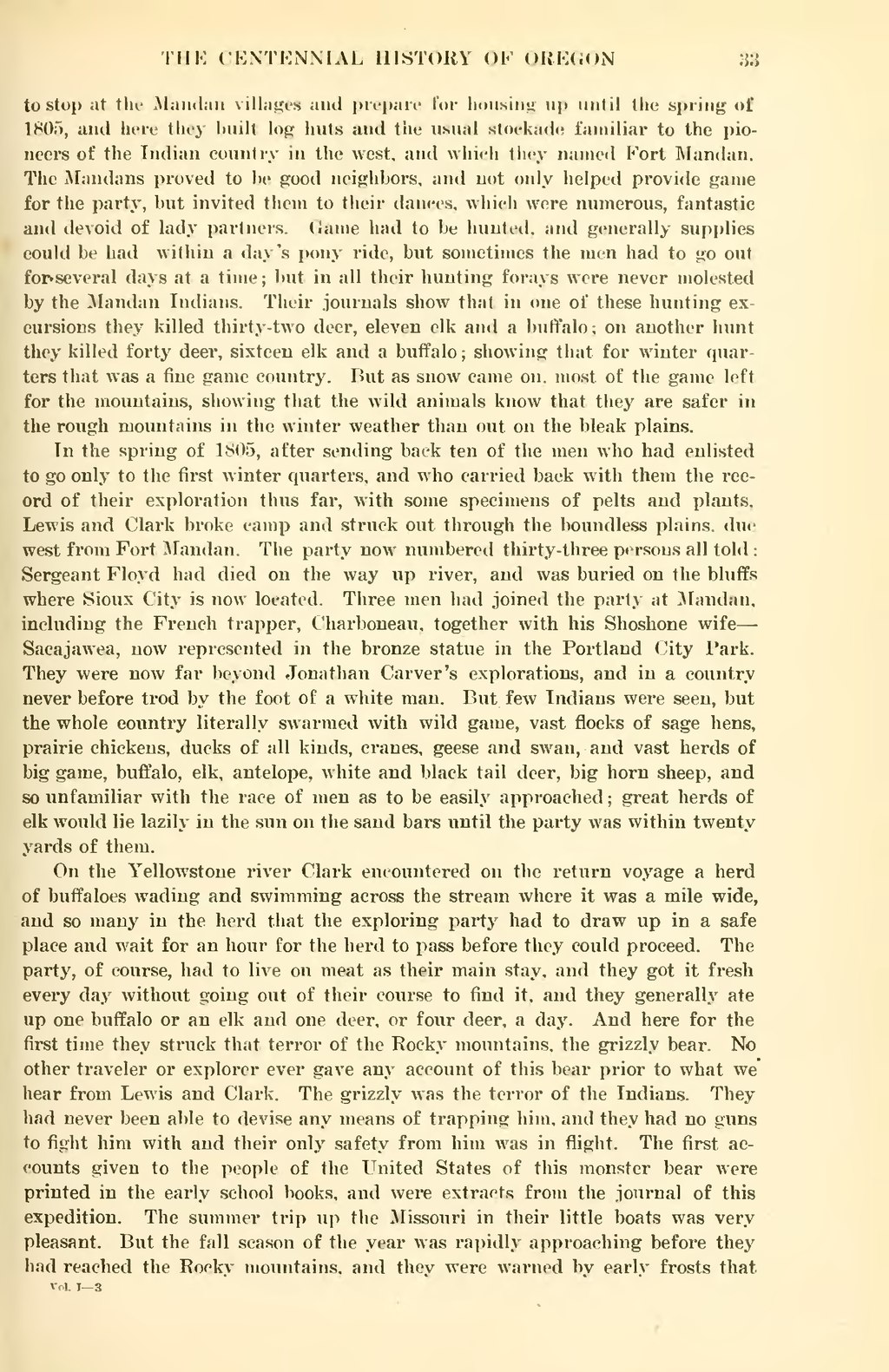THE CENTENNIAL HISTORY OF OREGON ?«
to stop at the Mantlaii villages aod prepare for liousiiiji ui) until the spring of 1805, aud here they built log huts and the usual stockade familiar to the pio- neers of the Indian country in the west, and which they named Fort Mandan. The Mandans proved to be good neighbors, and not only helped provide game for the party, but invited them to their dances, which were numerous, fantastic and devoid of lady partners. Game had to be hunted, and generally supplies could be had within a day's pony ride, but sometimes the men had to go out fo]>several days at a time ; but in all their hunting forays were never molested by the llandan Indians. Their journals show that in one of these hunting ex- cursions the.y killed thirty-two deer, eleven elk and a buffalo ; on another hunt they killed forty deer, sixteen elk and a buffalo ; showing that for winter quar- ters that was a fine game country. But as snow came on, most of the game left for the mountains, showing that the wild animals know that they are safer in the rough mountains in the winter weather than out on the bleak plains.
In the spring of 1805, after sending back ten of the men who had enlisted to go only to the first winter quarters, and who carried back with them the rec- ord of their exploration thus far, with some specimens of pelts and plants, Lewis and Clark broke camp and struck out through the boundless plains, due west from Fort Mandan. The party now numbered thirty-three persons all told : Sergeant Floyd had died on the way up river, and was buried on the bluffs where Sioux City is now located. Three men had joined the party at Mandan, including the French trapper, Charboneau, together with his Shoshone wife — Sacajawea, now represented in the bronze statue in the Portland City Park. They were now far beyond Jonathan Carver's explorations, and in a country never before trod by the foot of a white man. But few Indians were seen, but the whole country literally swarmed with wild game, vast flocks of sage hens, prairie chickens, ducks of all kinds, cranes, geese and swan, and vast herds of big game, bu&'alo, elk, antelope, white and black tail deer, big horn sheep, and so unfamiliar with the race of men as to be easily approached ; great herds of elk would lie lazily in the sun on the sand bars imtil the party was within twenty yards of them.
On the Yellowstone river Clark encountered on the return voyage a herd of buffaloes wading and swimming across the stream where it was a mile wide, and so many in the herd that the exploring party had to draw up in a safe place and wait for an hour for the herd to pass before they could proceed. The party, of course, had to live on meat as their main stay, and they got it fresh every day without going out of their course to find it, and they generally ate up one buft'alo or an elk and one deer, or four deer, a day. And here for the first time they struck that terror of the Rocky mountains, the grizzly bear. No other traveler or explorer ever gave any account of this bear prior to what we hear from Lewis and Clark. The grizzly was the terror of the Indians. They had never been able to devise any means of trapping him, and they had no gims to fight him with and their only safety from him was in flight. The first ac- counts given to the people of the United States of this monster bear were printed in the early school books, and were extracts from the journal of this expedition. The summer trip up the Missouri in their little boats was very pleasant. But the fall season of the year was rapidly approaching before they had reached the Rocky mountains, and they were warned by early frosts that
